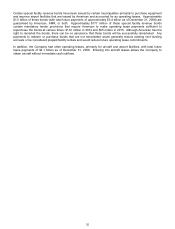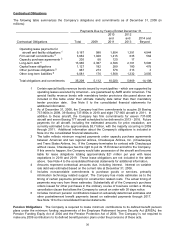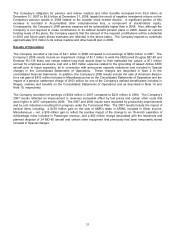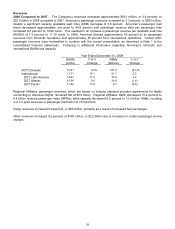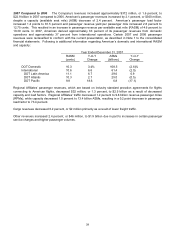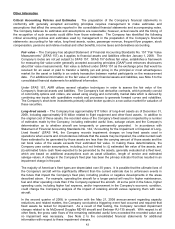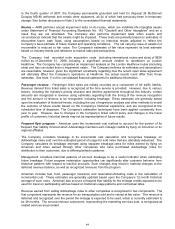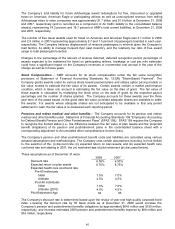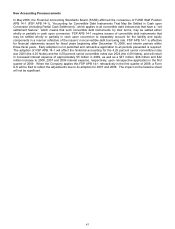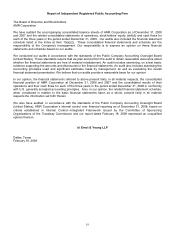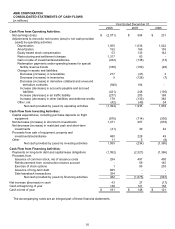American Airlines 2008 Annual Report Download - page 48
Download and view the complete annual report
Please find page 48 of the 2008 American Airlines annual report below. You can navigate through the pages in the report by either clicking on the pages listed below, or by using the keyword search tool below to find specific information within the annual report.
45
The Company’s total liability for future AAdvantage award redemptions for free, discounted or upgraded
travel on American, American Eagle or participating airlines as well as unrecognized revenue from selling
AAdvantage miles to other companies was approximately $1.7 billion and $1.6 billion at December 31, 2008
and 2007, respectively (and is recorded as a component of Air traffic liability in the consolidated balance
sheets), representing 18.2 percent and 18.7 percent of AMR's total current liabilities, at December 31, 2008
and 2007, respectively.
The number of free travel awards used for travel on American and American Eagle was 3.1 million in 2008
and 2.6 million in 2007 representing approximately 9.7 and 7.5 percent of passengers boarded in each year,
respectively. The Company believes displacement of revenue passengers is minimal given the Company’s
load factors, its ability to manage frequent flyer seat inventory, and the relatively low ratio of free award
usage to total passengers boarded.
Changes to the percentage of the amount of revenue deferred, deferred recognition period, percentage of
awards expected to be redeemed for travel on participating airlines, breakage or cost per mile estimates
could have a significant impact on the Company’s revenues or incremental cost accrual in the year of the
change as well as in future years.
Stock Compensation – AMR accounts for its stock compensation under the fair value recognition
provisions of Statement of Financial Accounting Standards No. 123(R) "Share-Based Payment". The
Company grants awards under its various share based payment plans and utilizes option pricing models or
fair value models to estimate the fair value of its awards. Certain awards contain a market performance
condition, which is taken into account in estimating the fair value on the date of grant. The fair value of
those awards is calculated by multiplying the stock price on the date of grant by the expected payout
percentage and the number of shares granted. The Company accounts for these awards over the three
year term of the award based on the grant date fair value, provided adequate shares are available to settle
the awards. For awards where adequate shares are not anticipated to be available or that only permit
settlement in cash, the fair value is re-measured each reporting period.
Pensions and retiree medical and other benefits – The Company accounts for its pension and retiree
medical and other benefits under Statement of Financial Accounting Standards 158 “Employers’ Accounting
for Defined Benefit Pension and Other Postretirement Plans” (SFAS 158). SFAS 158 requires the Company
to recognize the funded status (i.e., the difference between the fair value of plan assets and the projected
benefit obligations) of its pension and postretirement plans in the consolidated balance sheet with a
corresponding adjustment to Accumulated other comprehensive income (loss).
The Company’s pension and other postretirement benefit costs and liabilities are calculated using various
actuarial assumptions and methodologies. The Company uses certain assumptions including, but not limited
to, the selection of the: (i) discount rate; (ii) expected return on plan assets; and (iii) expected health care
cost trend rate and starting in 2007, the (iv) estimated age of pilot retirement (as discussed below).
These assumptions as of December 31 were:
2008
2007
Discount rate
6.50%
6.50%
Expected return on plan assets
8.75%
8.75%
Expected health care cost trend rate:
Pre-65 individuals
Initial
7.5%
7.0%
Ultimate
4.5%
4.5%
Post-65 individuals
Initial
7.5%
7.0%
Ultimate (2010)
4.5%
4.5%
Pilot Retirement Age
63
63
The Company’s discount rate is determined based upon the review of year-end high quality corporate bond
rates. Lowering the discount rate by 50 basis points as of December 31, 2008 would increase the
Company’s pension and postretirement benefits obligations by approximately $643 million and $150 million,
respectively, and increase estimated 2009 pension and postretirement benefits expense by $66 million and
$16 million, respectively.


